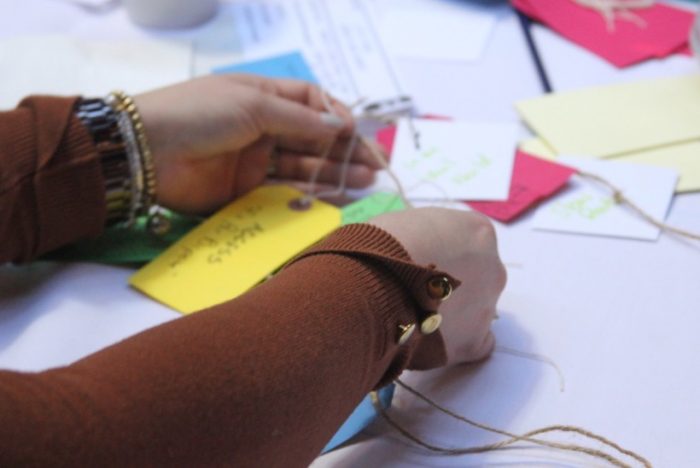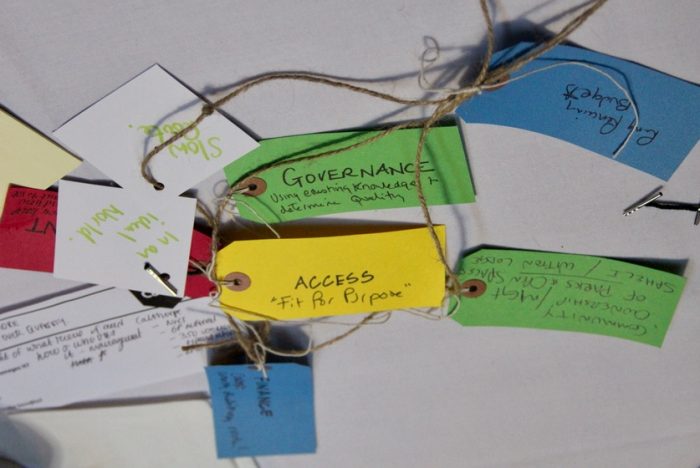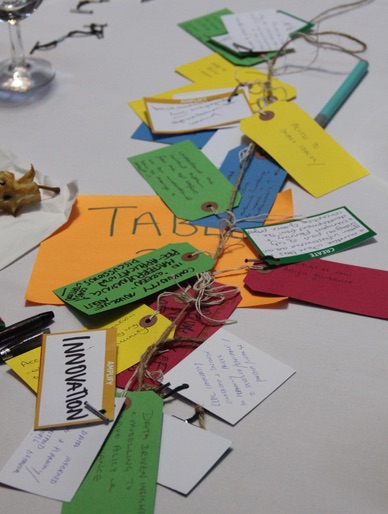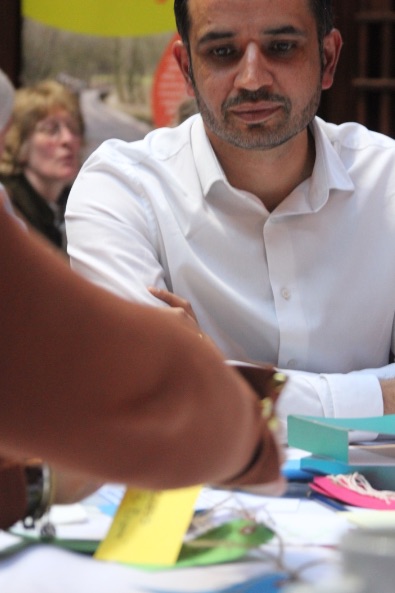#brumparks Afternoon session – turning the visions into practical possibilites…

These won’t be complete notes – we’ve been trying to capture quite wide ranging conversations on a number of tables… their was a specific process to connect actions to the ideas from this morning, which emerges slowly from these tables. The specifics from this are more likely to come later.
Table 1
The vision set here was Learning to take pride in Green Birmingham.
The challenge was how to provide education across the city which encouraged people to make use of the green space in a wider sense and to have the skills and attitudes to make it easier for people to use the parks and to walk more and cycle more and engage with nature.
Caroline from Martinuea Gardens says that they already do something similar on a smaller scale. http://www.growingbirmingham.org/ was also mentioned.
Some points in discussion
- Good land management is something that we need to do and is good to do. Because of budget pressures we think we can’t afford to do that, and part of the issues is that we look at everything through the lens of our finances.
- There are pragmatic issue about how parks – old or new are maintained.
- At the moment everyone looks at the parks as a liability. However we need to tackle inactivity amongst citizens and the parks and greenspaces and green pathways are a way to do that. It then becomes a very cost effective resource to deliver those outcomes.
- Difficulty is that everyone is so short terms fighting budget cuts – how to make the longer term change.
Then moved onto how to help realise this education plan to encourage a more wide ranging and widespread use of space..
Wilding Birmingham is an idea that encourages people to experience the outdoors as messy and dirty and we need to re-learn that.
What can we learn from Malmo and Chicago?
Possible Actions
Mapping the green spaces and letting people know they are there. Signs should say how long it takes to walk somewhere and how many calories they will burn doing it.
Potentially find a cluster of schools to re-design their curriculum to spend more time outside.
Incentive is that young people are more attentive and work better if they spend more time outside.
Re-educate adults to understand that outside is not risky.

Table 2
Headline was Changing the (way we) plan – and their idea was for “real community involvement in the planning process”
The conversation we dropped into was around – permissions and governance.how can people have say in planing – when planning is governable.
For instance when a unit has been designated as retail, then that’s retail, as long at the use doesn’t change then any “retailer” could go in there, SO if it’s Tesco and the community don’t want a Tesco then it doesn’t matter as you can’t discriminate. Retail is retail.
Another thread was if you do include community in planning then you have to include them Stirchley is an example, The community was consulted about what they wanted on their High Street but 15 years later nothing has happened and that’s left communities feeling powerless.

Table 3
Table 3’s headline is Greening the grey, their notes are:
Create
- Micro parks in unused spaces
- More green infrastructure in the city centre
Amplify
- More cycle friendly city, more off road cycle routes & better off road cycle lanes
- More “greening the grey” ie Bristol Street trees
- Park and ride initiatives to reduce traffic
The conversation started looking at each of the cards – and a feeling that we need to be careful calling all spaces “parks” open spaces don’t need to be a park. We could be greening streets.
We should have a strategic plan for a greener city which also includes a way to engage with people to take ownership and so that we work with communities, rather than them having things “done to” them – but the conversation led to a comment there also needs to a local understanding that communities won’t want to engage with a bigger vision if there street lights aren’t working, or their rubbish isn’t being collected.
Returning to table 3 after moving around to other tables their conversations has moved on discuss looking at upping the profile of “small planting” – small areas that have vegetables planted in them, guerilla gardeners – as well as the flowers. We need to raise the profile of people who are growing in spaces that would be grey and allotments – theses are our green outdoor spaces too and growing food has health benefits
There is already Harestometer http://www.capitalgrowth.org/the_harvestometer/ – a tool for measusring the amount of food a city grows and Growing Birmingham could use this, If we’re looking at a 25 year plan for pubic spaces, then food production has to play a part in it.
Table 4
Table 4 have the headline “Community Connectivity and Health”.
The notes under the headline are all “create” notes from this morning and they are:
- Activities for specific age groups
- Physical activity stations
- Support walks activities
- Linear greenways and parkways, using the natural geography to to connect green spaces.
There is conversation around the table that a lot of these things are already happening in the city, and the pros and cons to this.
There are already lots of walking groups in the city, look at “active parks” – and so that maybe is a nod to an earlier discussion that the problem in the marketing.
Budgets for physical equipment, you may raise money for capital purchases, but where does maintenance costs come from – and who maintains them.
There is also an acknowledgement that the ideas the group were left with all seems to need “someone” to lead, with no idea of who that “someone” is and that you can not rely on volunteers to manage all the parks and activities across the city – so where does the money come from? Could we have a ring fenced element to our council taxes for spaces.

Table 5’s headline is “Revival” They have an idea to discuss from the morning sessions Less is more, Quality of Quantity.
They are discussing use of parks and spaces different groups want something different from our parks, Dog walkers, young people. Etc. Often anti social behaviour is reported in parks, but in reality football playing, loud children, teenagers hanging out, that’s just normal park use!
Parks are unique in bringing people together and the only thing people have in common is the love of the space.
You can’t take autistic children into noisy crowded parks so they are not necessarily accessible to all.
So how does it work?
Do you start with audit of open spaces to see what’s working and what’s not?
Which bits of which parks have no value or potential? And how do you manage it – when you have had people tied to trees to protect their spaces – when we might not value as a space but the communities do.
Save
Save
Posted on 2nd November 2016

Connect with us
@BOSFonline